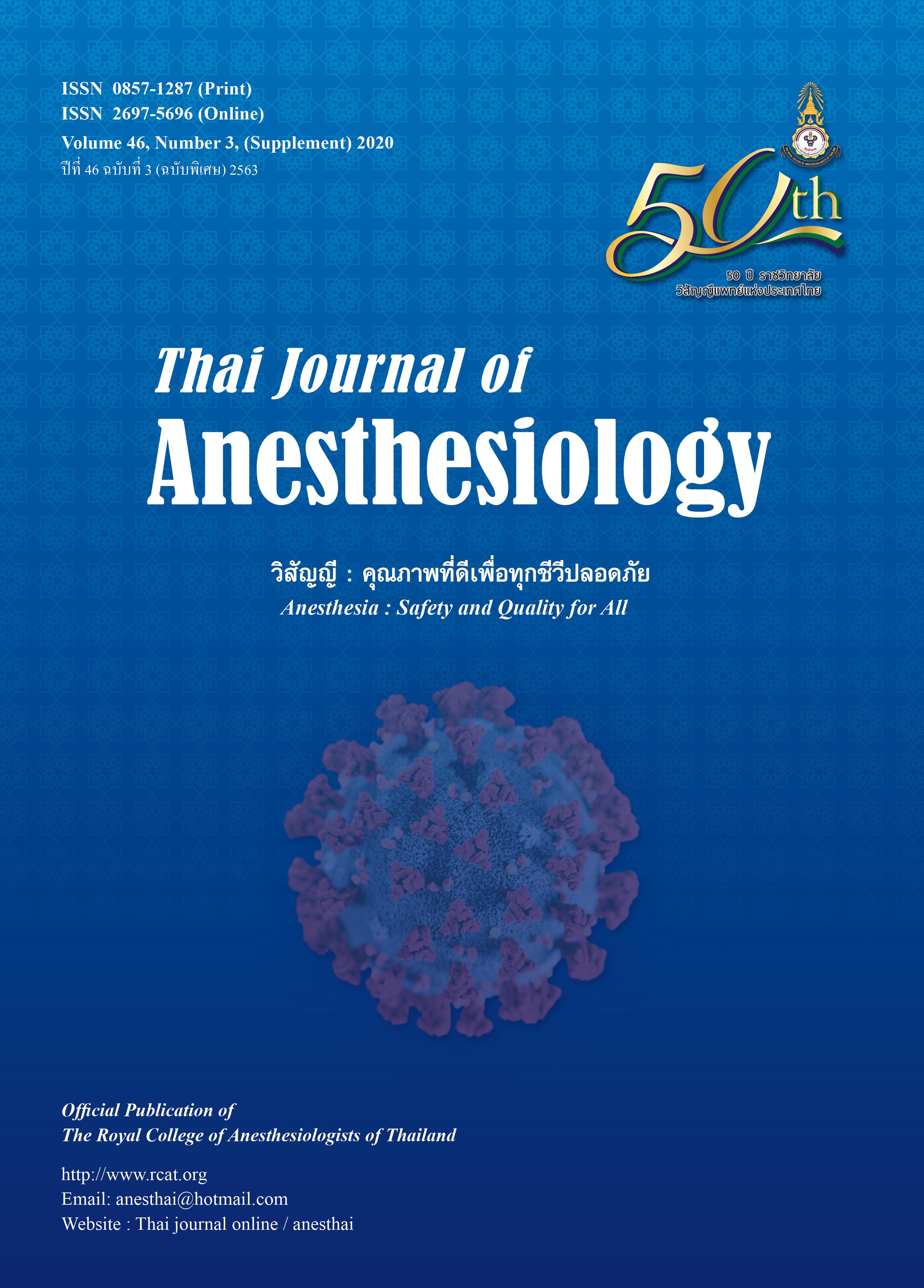The Innovation of Protective Barriers for Airway-related Procedures during the COVID-19 Pandemic in Thailand
Main Article Content
บทคัดย่อ
Airway-related procedures are considered a high-risk
procedure for droplet transmission to medical personnel,
especially during the COVID-19 pandemic period. Many
protective equipment aim to limit the spreading of
contamination have been emerged. We collect the data,
by interviewing the developers and review these locally
developed protective barriers by developers, authors and
experts.
Many innovations of the protective barriers have been
emerged during this period and can be categorized into 3
groups; simple boxes, simple tent, and box or tent with the
application of negative pressure onto them. Each model
has its own advantages and limitation. These protective
barriers may alleviate risk of the viral transmission during
the airway-related procedures, however, the operators
should still apply standard personal protective equipment
according to the risk and institutional recommendation. As
the intubation with these protective barriers can be
challenging, the operator should exercise the procedure
in a simulating environment before applying to the patients.
Article Details
เอกสารอ้างอิง
becoming infected with novel coronavirus disease 2019
(COVID-19) in China. J Hosp Infect 2020. doi: 10.1016/j.
jhin.2020.03.002.
2. Chen W, Huang Y. To protect healthcare workers better, To
save more lives. Anesth Analg 2020. doi: 10.1213/ANE.
0000000000004834
3. Bong CL, Brasher C, Chikumba E, McDougall R, Mellin-
Olsen J, Enright A. The COVID-19 Pandemic: effects on low
and middle-income countries. Anesth Analg 2020. doi:
10.1213/ane.0000000000004846.
4. Chen X, Liu Y, Gong Y, et al. Perioperative management of
patients infected with the Novel Coronavirus: recommendation
from the Joint Task Force of the Chinese Society of Anesthesiology
and the Chinese Association of Anesthesiologists.
Anesthesiology 2020. doi: https://doi.org/10.1097/ALN.0
000000000003301.
5. Orser BA. Recommendations for endotracheal intubation of
COVID-19 patients. Anesth Analg 2020. doi: 10.1213/
ANE.0000000000004803
6. Australian Society of Anaesthetists. Anaesthesia and caring
for patients during the COVID-19 outbreak [Internet]. 2020
[cited May 2020]. Available from: https://www.asa.org.au/
wordpress/wp-content/uploads/News/eNews/covid-19/
ASA_airway_management.pdf .
7. Nebraska Medicine and the University of Nebraska Medical
Center. Guidelines for patients with COVID-19 suspected or
confirmed infection in the perioperative environment
[Internet]. 2020 [cited May 2020]. Available from: https://
www.nebraskamed.com/sites/default/files/documents/covid-
19/guidelines-for-patients-with-covid-in-the-perioperativeenvironment.
8. Canelli R, Connor CW, Gonzalez M, Nozari A, Ortega R.
Barrier enclosure during endotracheal intubation. N Engl J
Med 2020. doi: 10.1056/NEJMc2007589.
9. Chen G, Irie T. COVID-19 safety innovations: intubationextubation
boxes v3: thinking inside the box [Internet]. 2020
[cited May 2020]. Available from: https://www.mskcc.org/
msk-covid-19-innovation-hub/covid-19-safety-innovationsintubation-
extubation-boxes.
10. Everington K. Taiwanese doctor invents device to protect
US doctors against coronavirus, Taiwan News [Internet].
March 23, 2020 [cited May 2020]. Available from: https://
www.taiwannews.com.tw/en/news/3902435. opens in new tab
11. Canelli R, Connor CW, Gonzalez M, Nozari A, Ortega R.
Barrier enclosure during endotracheal intubation. N Engl J
Med 2020 Apr 3. doi: 10.1056/NEJMc2007589.
12. Rosen M, Hillard EK. The use of suction in clinical medicine.
Br J Anaesth 1960;32:486-504.


